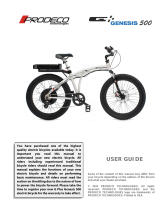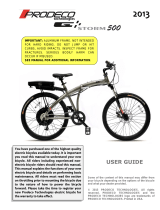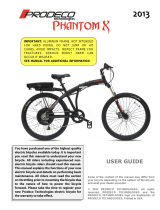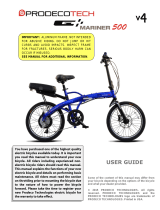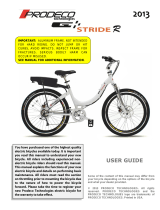Page is loading ...

3
INTRODUCTION
WELCOME TO THE MONTY FAMILY
Firstly, we would like to welcome you and thank you for choosing the Monty brand
This “User’s Manual” for your new Monty electric bike (DPIE 3) contains important
information and necessary to keep your bike in good condition. It has been designed so
that you can enjoy of your vehicle safely, making the most of your time.
Please read this manual carefully before using your new electric bike ( hereafter:
DPIE 3 ), and save this manual for future reference. If you have any doubts or questions,
please contact your authorized Monty dealer. Your DPIE 3 is fitted with a top-quality
engine and a battery of long-lasting which will not require much maintenance. Its
innovative design and safe construction will provide you with km. of satisfaction.
Parents or guardians should explain the contents of this manual to any minors
using the DPIE 3, to ensure that they have understood its contents.
The drawings and images may not correspond exactly to your model. They are
used solely to facilitate your understanding. We apologize if any part of this manual does
not correspond with the precise characteristics of your DPIE 3.
At Monty, we always strive to improve our products. As such, we may incorporate
other new technical components to the models or change pieces without prior notice.
Always, hand this manual to any future owner of your DPIE 3.
The Monty family is constantly innovating to offer its clients a top-quality product
made from the best materials. A clear example is our new electric vehicles. They provide
a new means of light and fun transport which is also ecological, silent and does not
pollute. Suitable to any age by their handy and economical use. For this reason, we want
to thank you for choosing us, a decision which will benefit the environment and definitely
all of us.
Thank you for dedicating few minutes to read this manual. We hope to have got a
product of your requirement..
For further information about our products, visit our webpage: http://www.monty.es

4
IMPORTANT WARNINGS
NON-FULFILLMENT OF THE INSTRUCTIONS DETAILED IN THIS
MANUAL MAY LEAD TO MECHANICAL FAILURES, A LOSS OF
CONTROL AND POSSIBLE FALLS, WITH SERIOUS PHYSICAL
INJURIES TO THE USER OR OTHERS, INCLUDING EVEN DEATH
INCORRECT USAGE MAY ALSO RISK YOUR PHYSICAL INTEGRITY
AND THAT OF OTHERS.
SAFETY WARNING
DO NOT OPEN OR MANIPULATE THE BATTERY, DOING SO WILL
FORFEIT THE WARRANTY ESTABLISHED IN THIS MANUAL.
IF YOU OPEN OR MANIPULATE THE BATTERY, CHARGER OR
ELECTRIC CIRCUIT, YOU MAY PROVOKE A SHORT-CIRCUIT AND
POSSIBLE INJURIES ( SHOCK OR BURNS ) .
WE RECOMMEND YOU TO USE ALWAYS THE HELMET
WARRANTY ADVISES
MODIFYING THE FRAME, FORK, OR ANY OTHER COMPONENT IMPLIES
THAT THIS VEHICLE NO LONGER CONFORMS TO OUR SPECIFICATIONS
AND THEREFORE ANNULS THE WARRANTY.
MANIPULATING THE ELECTRIC COMPONENTS OF THE VEHICLE WILL
ALSO FREE MONTY OF ANY POSSIBLE LIABILITY
SHOULD YOU HAVE ANY QUESTIONS OR DOUBTS, PLEASE CONTACT
YOUR AUTHORIZED DEALER OR VISIT OUR WEBSITE:
http://www.monty.es
CE (European Confirming)

5
1. ÍNDEX
SECTION PAG
PRESENTATION................................................................................... 3
IMPORTANT........................................................................ 4
1. ÍNDEX............................................................................................ 5
2. ICONS ........................................................ 5
3. DPIE 3 PARTS...................................................................... 6
4. GENERAL NORMS.................................................................. 7
5. VEHICLE ASSEMBLING ......................................... 7
6. USER’S GUIDE.................................................................. 8
7. VERIFICATIONS.......................................................................... 10
8. ADVICES..................................................................................... 11
9. SAFETY................................................................................... 11
10. MECHANICS AND MAINTENANCE
13
10.1 Wheels ............................................................................. 13
10.2 Handlebar and Stem.......................................................... 15
10.3 Headset and Fork....................................................... 17
10.4 Brakes............................................................................... 17
11. BATTERY AND CHARGER
20
11.1 Battery charging................................................................. 22
12. ELECTRIC COMPONENTS.................................................... 23
13. CLEANING.......................................................................................
23
14. TECHNICAL CHARACTERISTICS
24
15. MAINTENANCE CHARTS......................................................... 25
16. ADJUSTMENTS..................................................................... 25
17. SOLUTIONS............................................................... 26
18. FREQUENT QUESTIONS.......................................................... 27
19. FORM................................................................................. 28
20. GUARANTEE...................................................... 29
21. CONTACT AND DISTRIBUTORS................................................ 29
2. UNDERSTANDING ICONS
The following icons are in order to easy the manual understanding and to underline of
the important items.
SEE SECTION ADVICE
CAUTION MAINTENANCE

6
3. DPIE 3 PARTS
Optional: TOW
1. THROTTLE
2. IGNITION KEY
3. SADDLE
1
4. BATTERY LEVEL
5. BRAKE LEVER
6. STEM
7. SEAT POST RELEASE
1
8. QUICK RELEASE
9. BASKET
1
10. CHARGER PLUG
11. BATTERY CAGE
12. FORK
13. SEAT SUPPORT
1
14. DISC BRAKE
15. DPIE PLATFORM
16. LATERAL WHEEL NUT
17. CHARGER SWITCH
(1) optional parts

7
4. GENERAL NORMS
• Please read this manual carefully before using your Monty DPIE 3.
• Ensure that the bike works correctly before riding
• We recommend you not to change any of the DPIE 3 technical characteristics and not
to add any devices which may interfere with them.
• Recommended to use safety equipment
.
5. VEHICLE ASSEMBLY
The vehicle assembling shall be done in a light, level and clean place with some basic
mechanic knowledge. Or you can get in touch with your distributor or with Monty in order
to solve any problem.
• Components:
o D-PIE 3 platform
o Stem and Handlebar
o Integrated Charger
o Ignition key
o User’s manual
• Assembling instructions:
1. Take out all the parts from the box and verify to be all the required
items. Remove the D-PIE 3 protector cartons with care .
2. Fit the stem to the handlebar.
OPTIONAL: 3. Assemble the seat post to the platform, placing all the fastening nuts
as it is shown in the assembling scheme.
See section: MAINTENANCE AND MECHANIM for a right assembling.
• Charge of the battery
1. The battery must be charged on the whole before the first riding.
See section: BATTERY AND CHARGER for a right charge.
6. USER’S GUIDE
DESCRIPTION

8
DPIE 3 is a personal mobility vehicle, provided with a platform with three wheels,. The
integral electric engine is set on the front Wheel in order to give traction to the vehicle
and the steering through the handlebar as well, getting a great handling. One can change
the direction in a small space thanks to the position of the feet as well.
TYPE OF USE FOR WHICH THIS BIKE HAS BEEN DESIGNED
MONTY DPIE 3 and their components have been designed for standard or industrial
uses. Its handling is to surprise you. One shall get familiar to this vehicle in an area free
of obstacles and safe and later in enclosures or areas always provided with an even
ground. Incorrect usage other than the above or riding cross-county may lead to
premature wear and tear, loose joints and/or component breakage, thereby causing the
cyclist to possibly fall and/or injure himself/herself.
This vehicle is not recommended to children under the age of 12
.
This vehicle is not recommended to persons weighing more than 100 kg.
This vehicle is not allowed to be run in the public means. Please check the
local rules.
HOW THE DPIE 3 WORKS
MONTY DPIE 3 is simple and intuitive to be used.
Steps to follow before using:
1º Connect the electric system:
Make sure the charger to be off. Turn the contact key of the right lever to the position
“ON” (5), The led lights on the information panel found in the contact lever will light up,
Indicating the battery charge level (4). The DPIE 3 is ready to be run. The vehicle does
not produce any noise while is still
To
verify the battery charge while the vehicle is running is more exact than
to be stopped.
2º How to move the vehicle through the throttle:
DPIE 3 is provided with a throttle (6) set to the right grip in order to initiate the move of
the vehicle. If one turns opposite to the clock hands, the engine is to speed, if one turns
to the clock hands, the engine is to brake. It is provided of two shifters: one short and one
long (2) to be used according to ones requirements
.

9
3º How to stop or decrease the speed:
If one uses the brake lever (1), the engine assistance and the transmission are to be
interrupted so one shall grip the brake lever to stop the vehicle. Remember that the DPIE
3 is only provided with a front wheel brake.
Figura 1
Figura 2
1 BRAKE LEVER
2 SPEED INTERRUPTOR
3 HORN PUSH-BUTTON
4. BATTERY NIVEL INDICATOR
5. IGNITION KEY
6. THROTTLE
Remember
that the brake, for safety, works on the electric system,
cutting the engine current.
Important
:
Before using the vehicle please see the section:
“VERIFICATIONS” Y “SAFETY”

10
7. VERIFICATIONS
Check before riding for the first time
The vehicle has been verified at the Monty factory before to be on sale, Nevertheless,
one should check the following components to be securely fastened before riding the
DPIE 3 for the first time:
• Correct position of the front brake: lever, cable and disc.
• Correct tight of the wheel nuts.
• Correct pressure of the tires.
• Correct wheels align.
• Correct folding security system.
• Correct tight of the quick-fastening clamps.
DPIE 3 does not require any initial kind of lubrication, it is prepared to travel the first km.
without any type of maintenance, afterwards, the standard maintenance.
DPIE 3 and its components shall be checked before riding. Remember that if one detect
any problem which can not solved by oneself, please contact with an official dealer.
Take as usual the following checks before riding the vehicle
Verifications before riding:
•
WHEELS
• HANDLEBAR AND STEM
• HEADSET AND FORK
• BRAKES
• BATTERY AND HARGER
It is extremely important
the br
a
k
es
to
work correctly for
one safety
and
that of others. Carefully check the brake system each time before riding
and do not use the DPIE 3 if a problem is detected.
See section: MECHANISM AND MAINTENANCE
8. ADVICES
• Keep your bike clean to ensure proper functioning.

11
• Protect the DPIE 3 against thieves. Use a lock for more security.
• Do not overpass the allowed weight.
•
Ride with care
•
.
See section: SAFETY.
• No additional passenger is allowed on the DPIE 3. ( one sole person )
• A speedometer can help to control the autonomy and maintenance of the
vehicle.
• Plan your route according to the autonomy of the vehicle.
• Avoid water entering into the bearings.
•
The battery must be charged in an airing area.
•
A programmer by the charger plug is to help in the charger task.
9. SAFETY
DPIE 3 preventive actions
1. To brake or stop the DPIE 3, the user shall grip the brake lever rightly, depending on
the circumstances and the engine is to be disconnected automatically. Bear in mind that
the brake system works as follows: One shall grip the left lever to brake the front wheel.
2. DPIE 3 must be ridden by one sole person.
3. On rainy or snowy days, reduce the speed to avoid incidents.
4. Avoid riding on rainy days, days with heavy snowfall or through flooded areas.
Efficient riding.
The autonomy and performance of the DPIE 3 depend on some factors.
These can be classified in two types:
• External related to the environment conditions (surface, weather, etc.).
• Internal related to the vehicle state and the running style as well.
The external factors cannot be changed but yes to select a route adapted to the
characteristics of the vehicle.
The internal factors more related to the user can be adapted in order to improve the
lasting of the battery and the life of the vehicle.
Advises:
• Use the short gear to move the vehicle.
• Keep the tire pressure rightly.
• Verify the wheel to turn easily and the brake not to touch to the disc.
• Keep a constant speed if it is possible.
• Do not brake the vehicle suddenly, let the vehicle to lose speed smoothly.
• Do not overload the allowed weight on the DPIE 3
DPIE 3 safety riding

12
As with any other activity, the use of this vehicle implies certain risks. To get the
Monty DPIE 3, such risks must be assumed by the user. In no case the dealer or
manufacturer are to be liable.
The riding of the DPIE 3 is different from the other vehicles by having three wheels, One
front central wheels and two rear ones. This vehicle stays even on turning to the contrary
from the bicycle performance. The right position in order to drive the DPIE 3 is placing
the feet each side of the central covering and in front of the rear axle. The control system
and the handlebar turns are effectuated by the hands. To improve the traction of the
vehicle on starting one shall bent forwards. On turning, the user shall bent the body
towards the inside of the turning. To brake, the action shall be made in a smooth and
progressive way.
Avoid suddenly and quick
turns, otherwise the vehicle c
an
lost the balance
and overturn. Extreme the precautions on the turns while the seat is used.
Not to get the body too much to the rear part of the platform, the vehicle could lost the
balance and the front wheel could get up.
Not to brake abruptly the vehicle could unbalance.
Not to ride stoop, kneeling or any other form except the right one
DPIE 3 is not made to get up / get down from the kerbs or to pass obstacles. In case that
one should face it, one should get down from the vehicle.
• A mechanical revision must always be done before getting on the DPIE3. Ensure
that the brakes work properly
• One must get familiarized with all the components of the DPIE 3.
• It is recommended to wear a helmet to ensure greater personal safety.
• Wear always appropriate shoes to use the vehicle correctly.
• Wear reflecting or very visible clothing whenever possible. Do not use the DPIE3
to jump. Attention with the irregular surfaces
• Keep the speed under control and safe to avoid losing control of the DPIE 3.
• Never ride with earphones as they reduce your ability to hear other vehicles.
• Never carry any additional passenger. No matter to be a kid. The handling
capacity and safety could be affected.
• Never load anything on the vehicle which might obstruct the vision or ability to
control the DPIE 3.
• Never shall the user hold himself on another vehicle while riding.
• Not to tow or be towed by other vehicles.
• Not to ride the DPIE 3 under the influence of alcohol or drugs.
• If it is possible, do not ride in adverse meteorological conditions, such as when the
visibility is low, in the dark areas or to be extremely tired.
•
Never allow minors under the age of 10 years to ride the DPIE 3.

13
ATTENTION: Caution regarding to the intensive use
As any mechanical device , DPIE 3 is to wear down with different efforts.
The different materials and components used may react differently to this
daily decline. If the lasting life of a given component has been exceeded, it
may suddenly break, injuring the user. The cracks, scratches or
discoloration in the areas subject to intense use indicate that the component
has exceeded its useful life and must therefore be replaced.
10. MECHANISM AND MAINTENANCE
10.1 WHEELS
The rims and tires are an extremely important part of the DPIE3 and they should be kept
in right condition. Check the right pressure and control the wear out of the tires and the
rim conditions
. Make sure that the wheels are well placed and fitted.
TIRES
The tires are to be in good state and properly inflated and the tread to be neither cracked
nor worn down. The drawing pattern must keep as the minimum 2 mm in order to
provide good traction.
The sizes are indicated on the sides of the tires. Make sure to get the tires suitable to
the rim and the type of the vehicle
ADVISE
:
The front
tire
wears
down quicker
than the others by
the
traction, avoid to slip on the starts.
The feet should be placed forwards on
the platform in order to get more grips.
CAUTION
: When replacing a tire, make
sure to be suitable to the rim
and the type of the vehicle
. The DPIE 3
tires are different from the
standard ones.
Tire pressure
Tires must be inflated to the right pressure to ensure the bike works properly.
The valve is the “ Schrader” type like the ones used by the cars. To inflate the tyre, the
valve shall be removed, then and place the nozzle on the valve, ensuring that no air
escapes , check the pressure and place the cap back on the valve to keep it from getting
dirty. If the inner tube gets flat, it is recommended to be changed not to repair it .
Remember
:
The maximum air pressure is indicated
on the lateral tires
side

14
The air pressure must be checked regularly
PRESSURE TABLE
Wheel
Recommended
Maximum
Bar
Kpa
PSI
Bar
Kpa
PSI
Front
1,0 100 15 1,4 140 20
Rear
2,0 200 30 2,0 200 30
Equivalences (approx.): 1 Bar = 100 Kpa = 14,5 PSI
Wheels removing
To remove the wheel in case of a tire getting flat or any other reason, one shall follow the
following steps:
Front wheel:
Make sure that the contact is out and remove the key. Disconnect the cable connector, in
case that the vehicle was provided with it. Loose the wheel axle nuts counter clockwise
with a fixed key. Remind the situation of the safety washers towards the assembling.
Remove the wheel in a vertical down position.
To assemble the wheel, place the wheel at its correct position. Fit the safety washers
and tie the nuts clockwise. Connect the engine cable and check the brakes to work
properly.
Rear wheels:
To remove the rear wheel, use a tube key suitable to the nut sizes. Loose the nut and
take out the wheel.. Remind the situation of the washers and the wheels. To fit the
wheels, place the washers and the wheels to their original place and order and tie the
nuts
See section: Torque value
10.2 HANDLEBAR AND STEM
The handlebar must be centred to the stem and perpendicular to the frame..
The handlebar is fitted to the stem by a plate with 4 screws. Loose the screws to regulate
the handlebar position. To fix the handlebar position in a right subjection, tight the
screws in alternate cross form.
The handlebar height can not be changed.
HANDLEBAR FOLDING AND ADJUSTMENT
The folding of the DPIE3 handlebar is easy and practical. Please check the explication in
order to get an easy and safety folding. Make sure that no cables are over-stretched or
pinched when moving the different parts

15
To fold the DPIE 3 handlebar: (A) to block the handlebar. (Figura 3) (Stem closing
system).
Figure
3:
STEM CLOSING
Figure 4:
FOLDING
FOLDING: First pull out the closing lever (1) (Figure 5) (Open the closing) move the
lever down and lateral to open the safety blockade. (Arrow 2) in (Figure 6) (unblocked
closing )
Move the stem in the rear direction. (Figure 4) (Folding)
Figure
5:
OPEN CLO
SING
Figure
6:
UNBL
OCKADE CLO
SING
UNBLOCKADE: To ensure the stem, place it in a vertical position again, Turn the stem
forwards, the safety blockade is to close automatically, later close the closing lever to
the final position (Figure 8) (Blockade closing).
The adjustment of the closing press can be regulated with the nut of the closing lever
Figure
7:
UNFOLDING
Figure
8:
BLOCKADE CLOSING

16
IMPORTANT
:
Make sure all the closings to be perfectly blocked,
your
safety depends on it.
The handlebar and stem must be fitted correctly positioned and tightened in a suitable
and safety position to the user.
Stem adjustment and subjection.
The stem is fitted directly to the fork tube, to make the adjustment, the lateral screws
shall be loose lightly (Figure 9) (Lateral screws), check the headset as it is explained on
the following item and tight the system again.
First, tight the central screw (Figure 10) (Central screw), and later the lateral screws and
check the Headset.
Figure
9: LATERAL SCREWS
Figure
10:
CENTRAL SCREW
10.3 FORK AND HEADSET
The headset must turn smoothly in both sides freely and be compact on the whole.
HEADSET INSPECTION
Inspect your vehicle’s headset once a month and check to make sure that it is neither too
tight nor loose. If either of these is the case, do not use the bicycle and take it to your
authorized dealer.

17
HOW TO CHECK THE PLAYS IN THE HEADSET ADJUSTMENT
Place oneself by the vehicle with the feet on the ground.
Squeeze the front brake while moving the vehicle forwards and backwards. Check if the
headset is loose. The headset is formed by guards and bearings which are in contact to
the frame below and above.
The handlebar and stem fitting can have a small play due to the stem holding system.
HOW TO CHECK THE HEADSET’S ADJUSTMENT
Place oneself by the vehicle with both feet on the ground. With the front wheel resting on
the ground, turn the fork and handlebar from left to right and vice versa. Look, listen and
feel if the headset is too tight, making a noise as turning or snagging at different points.
ADJUSTMENT
Adjusting the headset requires special tools and expertise. Please see section: Stem
adjustment and subjection. In case of any doubt, please check it with an authorized
dealer.
LUBRICATIÓN
The headset should be lubricated once a year. This requires specific know-how,
expertise and special tools, for this reason only an authorized dealer should do it.
ATTENTION
:
An incorrect headset adjusting may cause one to lose
control of the bike and fall down. Ensure that the headset and stem to be
correctly fitted before each use.
10.4 BRAKES
Ensure the correct work of the brakes. DPIE3 is only provided with a sole disc brake per
cable to the front wheel which allows to stop the vehicle without problems. The brakes
shall work and allow the vehicle stop at a safety and proper distance. On using the brake
lever, the engine is also disconnected. Check the brake shoes not to show any excessive
wear.
The DPIE 3 model is fitted with a mechanical disc brake system.
The brake system of this vehicle allows getting down the speed, a very safety critic
function. The following item explain how to inspect, adjust and even lubricate the DPIE 3
brakes.
CAUTION
:
As any braking system, an incorrect adjustment, poor
maintenance, or a bad use of the brakes may cause one to lose control of the
vehicle with all the consequences that this may imply. Never use the bike if the
braking system is not working correctly or if you suspect any type of problem
either with the brakes or their cables. If the brakes are not working correctly, one
may lose control and fall down. If the DPIE 3 is not working properly, fix it or
take it to an authorized dealer.
Adjusting the brake system is difficult if one does not have the necessary know-how,
experience and the necessary tools. We strongly recommend that any adjustment to the
brakes be carried out by an authorized dealer.

18
Not all brakes are compatible with all types of levers. For any brake, be sure to use only
compatible levers such as those that come originally with the DPIE 3.
MECHANIC DISC BRAKE
The mechanic disc brake press the brake shoes/ pads on the disc placed on the front
hub instead of pressing the pads on the rim. The disc is fitted to the axle by bolts to the
left side. The brake works by a cable coming from the lever to the pincers. The brake
system is formed by:
Brake lever
Brake cable & casing
Brake pincers
Brake shoes / pads.
Disc
ATTENTION
:
The disc brake shoes can be very hot after using them,
please take care not to touch the disc on checking them.
INSPECTION
Squeeze the brake lever 5 times before riding. The levers must not touch the handlebar.
Ensure that there is no oil, grease or any other matter on the disc. The disc is part of the
braking system and should always be kept clean. Remove the brake shoes from the
pincers for in-depth cleaning. Do not use any clean products, degreasing liquids or
solvents to clean the disc. Use isopropyl alcohol.
Check once a month to ensure that the disc brakes are not worn down. If the brake pads
are less than 1mm thick, they will have to be changed. Check also to ensure that the
pads are correctly positioned: a distance between 0.25 and o.75 mm from the disc when
not using the brakes.. Turn the wheel while not pressing the brake lever. The pads
should touch the discs as little as possible..
See section: Torque Value
Check your brake cables once a month to ensure that they are not twisted or rusted, that
there are no broken threads or ends, and check their casings for cuts or wear. Substitute
any defective piece.
AJUSTMENT
• How to regulate the cable tension use the tensor (T) and fix it with the locknut
• How to adjust the separation between pad with respect to the disc:
Turn the pad’s adjustment screw. (A). To increase the separation, turn it counter-
clockwise. To reduce the distance, turn it clockwise.
How to align the brake with the disc: Loosen the brake mount bolts (P). Squeeze the
lever completely and gradually tighten the bolts.
• How to remove the brake shoes: the pincer shall be taken out and with the fingers or
thin-nosed pliers, grip the tab of the brake shoes and pull it.

19
A: Adjuster nut, (set in the inside face).
P: Assembling bolts of the pincer
T: Tensor
F: Fitting screw cable.
S: Assembling bolts to the fork.
Figure 11
Important:
The brake lever corresponds to the front Wheel
.
11. BATTERY AND CHARGE
The battery is one of the most important part of the DPIE 3. A correct use of the battery is
to last its life.
The battery can provide 300 chargers approximately.
Very important: Do not allow children to charge the battery. The electric
charge (220 v), may cause serious personal injury or even death. Do not
charge the battery barefoot, on a damp or wet floor or in any conditions which
might threaten your personal safety. The wall sock must meet the pertinent
safety norms.
GOOD USE OF THE BATTERY
The first charge of the battery is extremely important and can determine the battery’s
useful life. Charge the battery complete (4/6 hours approx.). The charger lights are to
indicate the state of the charge.

20
Before using the DPIE3, the battery shall be charged before to be discharged on the
whole, and will last the battery. The battery never should be run out on the whole. It does
not matter the km run. Charge always the battery after having used the vehicle. In case
of not using the vehicle, remember that the battery shall be charged at three or four
weeks.
Very important
:
Always use the charger corresponding to your model
.
Any manipulation of the battery by the client will invalidate the warranty and free the
manufacture of any possible liability.
Charge the battery in a well-ventilated area.
The batteries have discharge, It is normal the battery can have run out after a period of
time without using it.
BATTERY AND CHARGER CHARACTERISTICS
CHARACTERISTICS ITEMS
Type Lead Acid
Voltage 48 V. (12 X 4)
Capacity 12 Ah.
Lifetime (years ) 2 Approx.
Number of the chargers 300 Approx.
Charge time 4-6 hours
Charger High power
Charger (input) 115/220 VAC 60/50 Hz
Charger (output) 48 VDC
Charger fuse 10 A
BATTERY CHARGE INDICATORS
El DPIE 3 provides a battery charge indicator on the right grip. (Figure 12). This indicator
has 5 light: 3 Green, 1 Orange, 1 Red. It is similar to a traffic lights.
Figure 12
/




